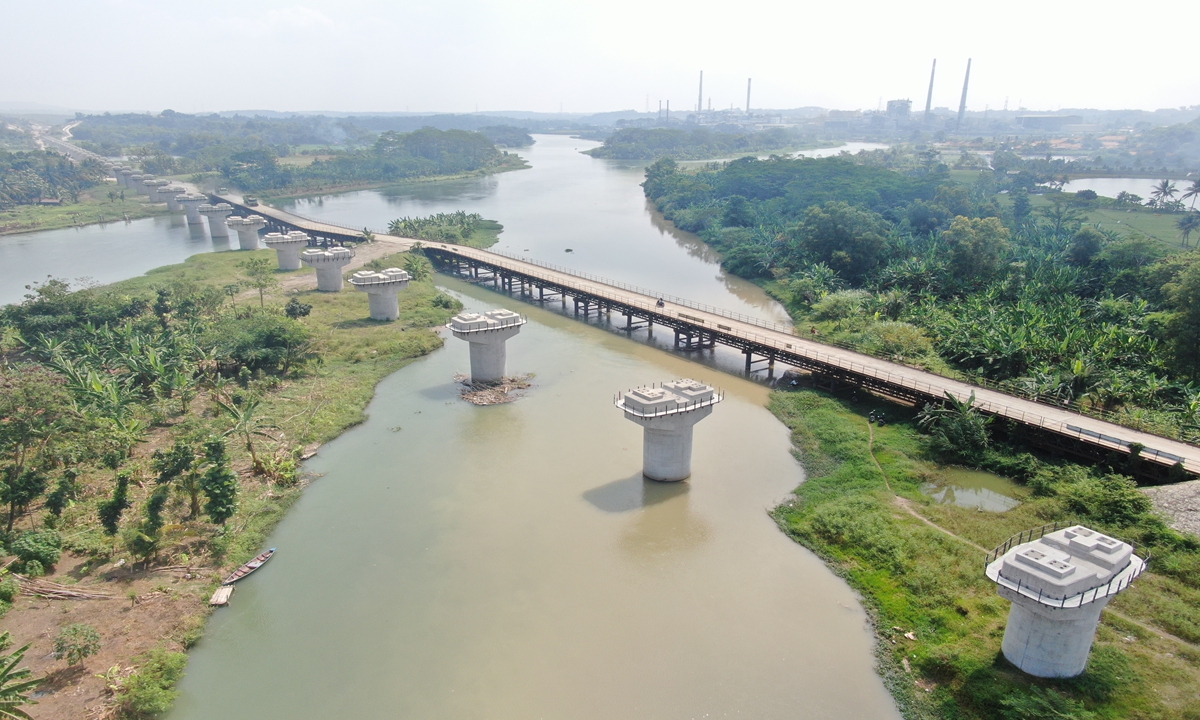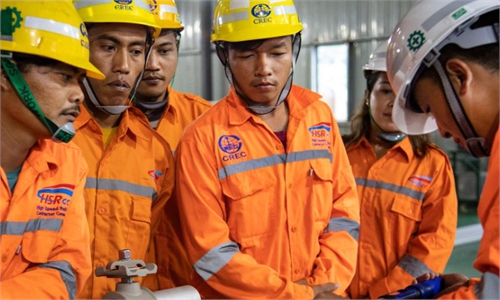Jakarta-Bandung HSR demonstrates the vitality of Chinese manufacturing; boosts local economy and industry: Chinese developers
Cooperation under BRI shows vitality of Chinese manufacturing, boosts Indonesian economy

A section of the Jakarta-Bandung HSR contracted to PoweChina under construction Photo:Courtesy of PowerChina
Editor's Note:
The Jakarta-Bandung High-Speed Railway (HSR) is a signature high-quality cooperative project between China and Indonesia under the China-proposed Belt and Road Initiative (BRI), demonstrating the vitality of Chinese manufacturing as well as China's efforts to deepen mutually beneficial cooperation with its neighbors under the principle of extensive consultation, joint construction and shared benefits. As the first high-speed railway in Southeast Asia with a designed speed of 350 kilometers per hour and the first case of the whole Chinese high-speed railway systems being exported to a foreign country, what is the significance of the project and the story behind the construction of the railway? The Global Times interviewed some of the engineers behind the landmark project to find out.
The Jakarta-Bandung High-Speed Railway (HSR), which connects Indonesia's capital Jakarta and its fourth-largest city Bandung, is a landmark project under the BRI and an example of the practical cooperation between China and Indonesia.
By October, all the 2,558 box girders for the Jakarta-Bandung HSR had been installed, 13 tunnels had been completed, and over 92 percent of roadbed and station civil works had been completed, People's Daily reported.
As the first high-speed railway in Southeast Asia with a designed speed of 350 kilometers per hour, the railway will cut the journey between Jakarta and Bandung from over 3 hours to around 40 minutes.
The project also marks the first time China's HSR has been developed abroad in terms of the whole system, whole method and whole industrial chain, integrating Chinese technical standards, survey and design, engineering construction, equipment manufacturing, material supply, operation management and personnel training.
Local economy boosted
Compared with other railway technology providers, Chinese companies offer the most cost-effective option, with a shorter construction period and a more stable and comfortable passenger experience, Zeng Weixian, a senior engineer of the China Railway No.4 Engineering Group Co, told the Global Times.
China Railway No.4 Engineering Group Co participated in the construction of a 27.55-kilometer-long rail line, as well as a number of stations, rail bridges and roadbeds.
"A mature construction speed allows a large reduction in costs for the host country. And once the railway is put into operation, it will immediately generate a revolutionary effect for the local economy and people's livelihoods, and more benefits will be reaped in the long term," Zeng explained.
Xin Xuezhong, director of the contractors in the Jakarta-Bandung HSR, told the Global Times that the railway project had made significant progress, completing over 90 percent of the total investment so far.
"Based on China's experience and the reference of other countries, the high-speed rail transport capacity will meet the travel demand of 30,000 people per day in the initial stage, and 60,000 people in five years," Xin said.
In addition to offering more commuting convenience to local people, the project is also expected to deliver a huge boost to Indonesia's economic development and social progress and help upgrade Indonesia's railway technology and related industries, which is a win-win situation for both sides.
Wang Kun, general manager of China Railway Group's management department for the Jakarta-Bandung HSR Project, told the Global Times that during construction, more than 60 percent of the procurement was locally sourced, which helped to cultivate and develop local infrastructure industry such as the industrial chain for concrete and bridge construction.
"After Chinese contractors provided their mature experience, local upstream and downstream contractors became familiar with this technology and the methods, and they can apply it to subsequent local infrastructure," Wang said.
Cooperation for a shared future
The Jakarta-Bandung HSR also offers a vivid illustration of endeavor to build a community with a shared future for mankind as the project has withstood the challenges under the COVID-19 pandemic.
The construction timeline of the railway has partly overlapped with the COVID-19 outbreak, however the project has not been suspended for a single day due to the epidemic, Wang said.
Wang said that during the construction of the Jakarta-Bandung HSR, ensuring the health and safety of local and Chinese employees was a primary concern.
"We shipped a large amount of medicines from China, treating all Chinese and foreign employees equally. We also formed a closed-loop management, providing free medicines and medical supplies," Wang said.
They also donated more than two million yuan ($282,000) to local hospitals and community residents to build a barrier of epidemic prevention, so that people in both countries can fight the epidemic together, Wang added.
In addition to the difficulties of the epidemic, the main difficulties include land expropriation and demolition.
"In the process, we took the initiative to contact the local villagers and the local people, having face to face communication to almost every village to respond to their concerns. Based on the deep and very detailed communication the project was carried out smoothly," Wang said.
Chinese technology shines abroad
Following the milestone project, more and more Chinese railways, Chinese bridges and Chinese roads have gone abroad in recent years.
China's energy infrastructure giant PowerChina, also a developer of the Jakarta-Bandung HSR told the Global Times the total contract value under construction of PowerChina in Indonesia exceeds $3 billion and it is also committed to the development and construction of local green energy projects in Indonesia, Laos, Vietnam, the Philippines and other regions and countries.
Going forward, China will continue to strengthen solidarity and cooperation with fellow developing countries including neighboring countries on the basis of the principles of sincerity, real results, affinity and good faith and with a commitment to the greater good and shared interests, and will do more to deliver more tangible benefits to them, Zhao Lijian said at a regular press conference on November 10.
It shows that with the further development of the BRI, Chinese manufacturing and technology have not only established a new "Chinese standard" for the world, but also brought real benefits to the countries along the BRI, such as economic development, job growth and advanced technology, Liang Haiming, dean of the Belt and Road Institute at Hainan University, told the Global Times on Wednesday.
By doing so it will break the Western monopoly in these fields, providing more and better choices to all countries in the world and connecting the countries along BRI and the whole world into a closer whole through Chinese technology, Chinese manufacturing and Chinese standards, as to jointly build a community with a shared future for mankind, Liang said.

